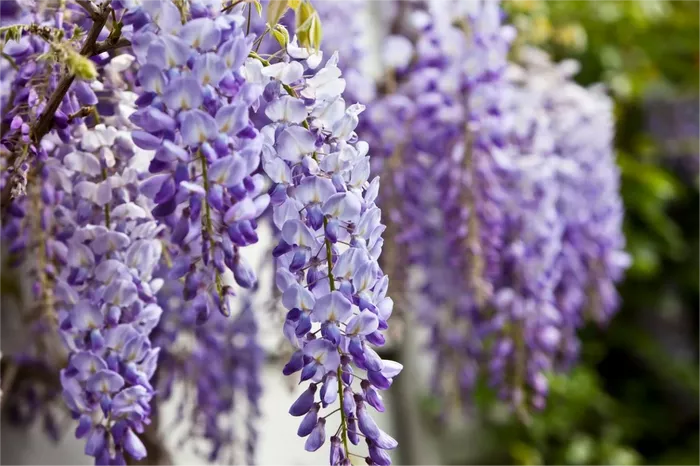Wisteria, with its cascading clusters of delicate blooms, is renowned for its beauty and fragrance. This woody vine, belonging to the pea family, is native to Asia and North America. Its ethereal flowers, ranging in hues from white to lavender to deep purple, adorn gardens, arbors, and pergolas, captivating admirers with their graceful charm.
As fleeting as their beauty may seem, wisteria flowers can be preserved through drying, allowing enthusiasts to enjoy their splendor long after the blooming season has passed. However, the process of drying wisteria flowers requires careful attention to detail to ensure optimal results.
Factors Affecting the Drying Effect of Wisteria Flowers:
Several factors influence the effectiveness of drying wisteria flowers:
1. Freshness: Choose wisteria blooms at their peak freshness, ideally when they are fully open but not yet starting to wilt. Fresh flowers retain their color and fragrance better during the drying process.
2. Humidity: Low humidity conditions facilitate faster drying, while high humidity can prolong the process and increase the risk of mold or mildew formation on the flowers.
3. Air Circulation: Adequate air circulation is crucial for even drying. Ensure that the flowers are spaced apart to allow air to circulate freely around each bloom.
4. Temperature: Moderate temperatures are ideal for drying wisteria flowers. Excessive heat can cause the flowers to become brittle and lose their color, while cold temperatures can slow down the drying process.
5. Preparation: Proper preparation of the flowers before drying, such as removing excess foliage and gently cleaning them to remove dirt or insects, can improve the drying results.
Methods of Drying Wisteria Flowers
There are several methods for drying wisteria flowers, each offering unique advantages and considerations:
1. Air Drying:
Gather a bundle of wisteria stems and secure them together with a rubber band or twine.
Hang the bundle upside down in a well-ventilated area away from direct sunlight.
Allow the flowers to air dry for several weeks until they are completely dried and crisp to the touch.
Check periodically for signs of mold or mildew, and discard any flowers that show signs of decay.
2. Silica Gel Drying:
Fill a shallow container with silica gel, a desiccant commonly used for drying flowers.
Trim the wisteria stems to the desired length and insert them into the silica gel, ensuring that the blooms are fully submerged.
Seal the container with a lid and allow the flowers to dry for several days to a week, depending on the thickness of the blooms.
Carefully remove the flowers from the silica gel and brush off any excess powder before displaying them.
3. Pressing:
Place individual wisteria blooms between sheets of absorbent paper, such as blotting paper or newspaper.
Arrange the flowers in a single layer, ensuring that they are not overlapping.
Place heavy books or weights on top of the paper to press the flowers flat.
Allow the flowers to dry for several weeks, replacing the paper periodically if it becomes damp.
Once dried, carefully remove the pressed flowers and use them for various crafts or decorative purposes.
4. Microwave Drying:
Place wisteria blooms between layers of paper towels or microwave-safe drying material.
Microwave the flowers on a low setting for short intervals, checking them frequently to prevent overheating.
Continue microwaving in short bursts until the flowers are dried to your desired level.
Allow the flowers to cool before handling them, as they may be hot immediately after microwaving.
Tips for Drying Wisteria Flowers
1. Choose the Right Time: Harvest wisteria flowers for drying when they are fully open but still fresh and vibrant.
2. Handle with Care: Wisteria blooms are delicate, so handle them gently to avoid damaging the petals or stems.
3. Remove Foliage: Remove excess foliage from the stems before drying to focus the drying process on the flowers.
4. Avoid Direct Sunlight: Direct sunlight can cause the flowers to lose their color and fragrance, so choose a drying location away from intense sunlight.
5. Monitor Progress: Check the flowers regularly during the drying process to ensure they are drying evenly and to detect any signs of mold or decay.
6. Experiment with Different Methods: Try different drying methods to find the one that works best for your preferences and conditions.
Conclusion
In conclusion, drying wisteria flowers is a rewarding way to preserve their beauty and enjoy them year-round. By considering factors such as freshness, humidity, and drying method, enthusiasts can successfully dry wisteria flowers to create charming arrangements, crafts, and decorations. With patience and attention to detail, the timeless elegance of wisteria can be cherished long after the blooms have faded from the vine.


